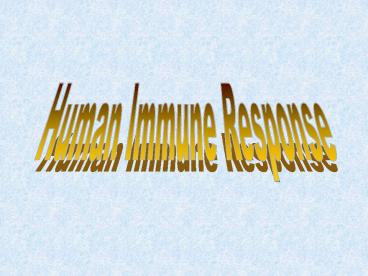Human Immune Response PowerPoint PPT Presentation
1 / 32
Title: Human Immune Response
1
Human Immune Response
2
Cells of Immune Response Summary
Leukocytes (white blood cells)
Lymphocytes
Phagocytes
Macrophage
Eosinophils
Neutrophils
Basophils
T Cells
B Cells
Helper T Cells
Natural Killer T Cells
Plasma B Cells
Killer T Cells
Memory T Cells
Memory B Cells
Supressor T Cells
3
Immune Response Summary
Macrophage Engulfs Foreign cell
Macrophage Alerts Helper T Cells
Helper T Activates B Cells
Helper T Activates Killer T cells
Killer T cells Destroy invaders
Memory B cells remember invasion
Memory T cells remember invasion
Plasma B cells Produce antibodies
Suppressor T Cells shut down response
Y
Y
Y
Y
Y
4
Antigens Antibodies
5
(No Transcript)
6
(No Transcript)
7
Humoral Immunity (response)
8
1. Macrophages Sound the Alarm
Note foreign antigens are recognized as
non-self
Note Macrophages activate the helper T cells
9
2. Helper T Cells "Learn" to Recognize Antigen
Note at the same time, the Helper T cell also
activates the Killer T cells (cellular immunity
/ response)
10
3. B Cells Produce Antibodies
- Plasma B cells produce antibodies that are
- specific to the antigen detected.
- Memory cells remember the shape of the specific
antigen
B cells divide into memory B cells and plasma
cells
11
4. Antibodies Destroys Pathogen
Antibodies bind with foreign antigens, which
destroy the pathogen or flag them for destruction
by macrophages and killer T cells.
12
5. Suppressor T Cell Stops Immune Response
13
Cellular Immunity (response)
14
The
immune response begins when a white blood cell
called a macrophage encounters a virus and
consumes it. Meanwhile, other viruses look for
nearby cells to infect.
1. Macrophage Sounds the Alarm
Next,
the macrophage digests the virus and displays
pieces of the virus called antigens on its
surface. Nearby cells have now become infected by
the attacking viruses.
2. Macrophage Presents Antigen
15
Unique
among the many different helper T cells (another
class of white blood cells) in the body, one
particular helper T cell now recognizes the
antigen displayed and binds to the macrophage.
3. Helper T-Cells Recognize Antigen
This
union stimulates the production of chemical
substances -- such as interleukin-1 (IL-1) and
tumor necrosis factor (TNF) by the macrophage,
and interleukin-2 (IL-2) and gamma interferon
(IFN-y) by the T cell -- that allow intercellular
communication.
4. Helper T-Cells Communicate with Macrophage
16
As
part of the continuing process, IL-2 instructs
other helper T's and a different class of T
cells, the killer T's, to multiply. The
proliferating helper T's in turn release
substances that cause B cells to multiply and
produce antibodies.
5. Helper T-Cells Activate B Cells Killer T
Cells
The
killer T cells now begin shooting holes in host
cells that have been infected by viruses.
6. Killer T-Cells Attack Infected Cells
17
The
antibodies released by the B cells bind to
antigens on the surfaces of free-floating
viruses. Besides making it easier for macrophages
to destroy viruses, this binding signals blood
components called complement to puncture holes in
the viruses.
7. B Cells Produce Antigens (humoral response)
Finally
, as the infection is brought under control, the
activated T and B cells are turned off by
suppressor T cells. However, a few "memory cells"
remain behind to respond quickly if the same
virus attacks again.
8. Suppressor T Cells Turn Off Response Memory
Cells "Remember"
18
Immunity Overview
19
(No Transcript)
20
(No Transcript)
21
Cells of the Immune Response
22
(No Transcript)
23
(No Transcript)
24
(No Transcript)
25
(No Transcript)
26
(No Transcript)
27
(No Transcript)
28
(No Transcript)
29
HIV Infection
30
(No Transcript)
31
(No Transcript)
32
This diagram shows 1. HIV binding to the CD4
protein 2. Injecting its RNA into the cell 3.
4. Viral RNA becoming DNA 5. 6. DNA entering
the nucleus 7. 8. DNA merging with the cells
DNA 9. 10. DNA producing viral RNA 11. 12.
Viral RNA assembling viral proteins 13. Viral
proteins surround RNA and mature into a virus 14.
A replicated virus is near complete. 15. 16.
The virus buds from the cell and leaves to find
other CD4 cells.

